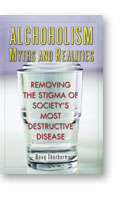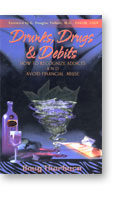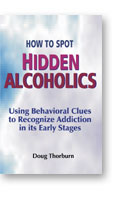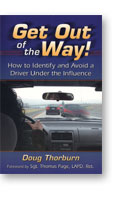|

The Mortgage Mess, the Real Estate Bubble and Alcoholism
This may seem a stretch, but humor me while we celebrate our third anniversary. We'll get to plenty of real life stories in which alcoholism is proven in the "Runners-Up" and other sections below (rarely have alcoholism-fueled antics so filled the news). This month's top story is based on theory, anecdotes and understanding how the mind of the alcoholic works and the consequential behaviors. While theory comprises proven hypotheses and anecdotes are real-life stories, extrapolating theory and individual stories to herd psychology hardly meets the criteria of scientific proof. However, this is a good time to make the attempt because it's becoming obvious that we are witnessing the hissing sound from air being let out of one of the great bubbles in the history of mankind (see my alter-ego Wealth Creation Strategies newsletter in which such real estate commentary began in late 2004, particularly the top stories in the 2005 editions, at www.DougThorburn.com). While there is no hard evidence to prove the assertion I will make beyond a reasonable doubt, as I often say in regards to identifying addiction--our minds are not courts of law.
Alcohol and other-drug addiction causes egomania, which is at the root of most behaviors destructive of others. Perversely, the egomania-impelled need to wield power sometimes results in grandiosity and even overachievement, which can provide unexpected benefits for society. Partly because of the extreme variance in behaviors and outcomes, addiction is not easily diagnosed by those outside this close circle.
Among those who can be particularly challenging to diagnose are leaders, whether heads of state or leaders in manias. Yet, alcoholism and alcoholics have a number of attributes supporting the idea that the disease could be at the helm of many manias. Let us count the ways.
1. Alcoholism causes brain damage to the frontal lobes, allowing the lower brain centers--including those responsible for emotions and the herding instinct--to ride roughshod over the neo-cortex, the seat of reason and logic. We might hypothesize that this allows alcoholics to better connect with others at an emotional level and to lead them, for better or worse. Manias require this sort of leadership.
2. According to the testimony of countless recovering addicts, they were the world's best salesmen when using and, as they often put it, could sell ice to Eskimos. Manias, disconnected from any economic or other reality, require just this sort of hucksterism.
3. Cult leaders are usually alcohol or other-drug addicts. Cults can do enormous damage despite the fact that followers need not be alcoholics and are often simply extreme codependents. As mentioned in Drunks, Drugs & Debits, "Jim Jones, an amphetamine and prescription drug addict and likely alcoholic, led 900 men, women and children in Jonestown, Guyana, to mass suicide in 1978." By no means were all of Jones' followers alcoholics. Likewise, Charles E. Dederich convinced former AA members to join his cult, Synanon, even while Dederich had long since relapsed. Many if not most of his followers remained sober. In similar fashion, we could argue that manias, which lead people to buy or do things they would never in their right minds consider at those prices or under similar sets of circumstances, could be taken to greater manic extremes by cult-like leadership.
4. Alcoholism causes the addict to experience distortions of perception and impaired judgment, one result of which is a feeling that he can do no wrong. This sense of invincibility leads to extraordinary risk-taking behaviors, including the commission of crime such as fraud and, on the other side of the coin, overspending. Fraudulent appraisals and loan applications became a large component of the real estate and lending mania, as did financial optimism on the part of debtors. This led many to spend and borrow far more than prudent and provided the funds with which to do so. Manias are driven by this sort of risk taking.
5. Alcoholism is also one of the causes of what appears to be Bipolar Disorder, or manic-depressive behavior. Manic periods are characterized by excessive optimism and result in both an "I can do no wrong" and "nothing can go wrong" attitude. Manias require such excessive and unrealistic optimism by leaders and followers alike. And it’s difficult to resist the infectious enthusiasm and all-too-believable lies of an addict who promises the moon; followers are far more likely to follow such charismatic types than an old fogy realist or pessimist.
6. The same impaired judgment leading to extreme risk-taking can also result in more frequent involvement with "get-rich-quick" schemes. James Woods' coke-addicted character Lenny Brown in the movie, "The Boost," jumped into one such scheme after another. In real life, Charles Ponzi, who perfected the pyramid scheme that bears his name and led countless victims into a financial nightmare in the early 1920s, was an alcoholic. Since roughly 85% of felons are alcoholics and committing financial fraud is, generally, a felony, 85% of con artists are probably also alcoholics. Unfortunately, as mentioned in the top story from July 2007 (L.A. City Attorney Rocky Delgadillo and his wife Michele), while the press corps is relatively diligent in outing celebrity addicts they are not as dogged when dealing with CEOs, politicians, professionals and ordinary business people.
7. Alcoholism causes egomania, often resulting in a pervasive "rules don’t apply to me" attitude. This, too, leads to criminal behaviors such as loan and appraisal fraud, which helped to fuel this bubble. I am personally aware of an alcoholic real estate agent who forged loan documents and almost cost her supervising broker, a good friend of mine, his license. As the bubble deflates, we will see many more stories like this and there are likely to be few that do not involve an alcoholic in the driver's seat.
8. Egomania also prompts many alcoholics in the early stages of their disease to overachieve. As a result, alcoholism is not an impediment to high office. Many alcoholics become successful CEOs and politicians until recklessness and impaired judgment does them in. We suspect (and have confirmed in a few instances) that at least some of the top brass at companies such as Tyco and Enron were alcoholics. A Wall Street Journal story on the rise and fall of New Century, one of several dozen recently imploded subprime lenders, reported a "party-hard" culture and a company that "took its employees on a boozy cruise to the Bahamas and threw one bash in a train station in Barcelona, Spain." One story does not an addict make, but the fact it was even reported is an indication there may have been far more alcoholism-fueled goings-on beneath the surface at such companies.
9. Due to excessive risk taking and a willingness to go to extremes, radical innovations may be far more common with alcoholism than without in areas as diverse as music, sports, sex and philosophizing. One of these areas may include finance, which has undergone extraordinary innovations in instruments such as subprime loans and collateralized debt obligations. Parties without any alcoholics can be relatively dull affairs, while an alcoholic or two may disrupt things just enough to get a party going. It is in the nature of addiction to increase instability, which is a necessary pre-condition for a boom and bust.
Please don't misunderstand. Not every real estate cheerleader calling for inexorably rising prices, great salesman, leader, or even criminal is an addict. However, addiction increases the ability to connect with the mark at the emotional level and get victims to do things they ordinarily wouldn't. As we have shown elsewhere, the disease dramatically increases the odds of criminal and unethical behavior, including overstating income on mortgage applications. In one recent study, 90% of a sample of 100 "stated income loans" reported "significantly" higher incomes than the borrowers claimed on their tax returns. While certainly not every borrower was an addict, we might surmise that most of the loan officers who countenanced such behaviors could be. Simply put, addiction greatly increases the odds of engaging in financial misbehaviors. Yes, the bubble was stoked by such devices as securitization of mortgages, which increased moral hazard, thereby encouraging loan brokers to approve loans regardless of buyers' ability to repay and cooperate with "liar loans" (no- or low-doc loans). However, financial shenanigans were a necessary component and alcoholics are far more likely than others to engage in questionable practices and may even be more likely to create and have the ability to sell such questionable financial innovations.
The recriminations will, of course, fly as anecdotes continue to surface. In one Los Angeles Times story, a self-employed handyman blamed his loan broker for failing to explain the terms of a loan on which his house payments jumped beyond his ability to pay, forcing him into bankruptcy. Yet he had purchased his home 19 years earlier, during which time real estate in his home town of San Diego appreciated by 300-400%. While he may have had to use equity to pay for treatment of a child's cancer, how many in similar situations refinanced to buy yet another car he couldn't afford or another boat he didn't need, or to pay off credit cards used for what may have been alcoholism-fueled overspending? How many times might he have figuratively walked into a bar and, big man that he is, offer to buy everyone a drink? Grandiosity, driven by alcoholism, has helped precipitate many financial debacles.
Extreme risk-taking behaviors including fraud likely rooted in alcoholism helped take this mania (and perhaps most others) to far greater extremes than in the absence of addiction (just as alcoholic-free parties are far more sedate than others). Some might object, "But addicts comprise only 10% of the population; therefore, they couldn’t have been responsible for more than 10% of the mania and consequential price rises." However, home prices--like all other prices--are set by the marginal buyer and seller. Only 2% of all shares of stocks traded on Black Monday 1987 and, therefore, what may have been only 2% of shareholders decided that shares were worth 20% less by the end of the day than on the preceding Friday. This gives a glimmer of the effect the last few buyers and sellers can have in determining prices. Prices would have likely settled far lower at the peak without the subprime borrower and speculators who got in with zero down and, therefore, no personal risk. (As I have said in my client newsletter, Wealth Creation Strategies at www.DougThorburn.com, easy loan terms helped sellers by driving demand for houses far higher than would have been the case without.*) This suggests that without the extraordinary herding instinct of alcoholics, booms and busts would likely be far more moderate.
* Andy Laperriere wrote in The Wall Street Journal (March 21, 2007), "Home prices--like all prices--are set at the margin. It was the marginal buyer, particularly the subprime borrower and housing speculator, who drover prices higher [who could operate as they did ONLY with easy loan terms]. The easing of lending terms increased the demand for homes, and since the supply of homes is relatively fixed (or inelastic), this increase in demand quickly translated into higher prices. As the loose lending practices are inevitably reversed--and there is a wide chasm between current lending practices and prudent lending terms--fewer people will be able to afford to buy a house, which will reduce demand and push home prices lower." .
Runners-up for top story of the month:
Al Gore lll, arrested for possession of marijuana and illegal prescriptions, including the opioid (synthetic opiate) Vicodin, the sedative-hypnotics Valium and Xanax, and the amphetamine Adderall. His brush with the law, which resulted from being pulled over for driving at 100 mph in Orange County, California at 2:15 a.m., was not his first. In August 2000 he was ticketed by the North Carolina Highway Patrol after doing 97 mph in a 55-mph zone; he avoided a charge of reckless driving by agreeing to a suspension of driving privileges in that state. Moving over to Virginia, military police arrested him for DUI in September 2002. He slipped into Maryland, where he was arrested for marijuana possession in 2003 and later ordered into a substance "abuse" program (it's not "abuse," a term that evokes an image of college kids drinking too much; he's an addict). North Carolina law enforcers did him no favors by their apparent failure to test for DUI and compromising his sentence in a way that allowed him to "pull a geographic" with impunity, until now. The rest of us have just been lucky that he hasn’t killed someone.
Actor Tom Sizemore, sentenced to 16 months in prison for yet again violating probation. He tearfully pleaded with Judge Cynthia Rayvis for leniency, begging her, "If you would please just give me one more chance for myself." Because a tearful plea for another chance in 2005 got him a reinstatement of probation and a plea for mercy in 2006 resulted in an additional three years probation, the judge properly decided that Sizemore "needs to be in a lockdown setting" for there to be any hope of recovery from his methamphetamine and other-drug addiction. He was arrested in early May for possession and found to be under the influence of meth, opiates and marijuana.
Pop star Britney Spears, who conducted herself in classic "I don’t give a damn about anyone else" fashion at an OK! magazine shoot by wiping her greasy hands on the front and back of a designer gown after lunch, letting her puppy poop on a $6,700 gown and fleeing the shoot before it was over wearing almost $15,000 of OK!s clothing. So, who said, "I’m a celebrity! I can do anything I want!"--Britney or Lindsay? (Trick question. With the variation, "You don't know who I am! I can do anything I want!" the correct answer is almost every alcoholic celebrity who’s ever lived.)
Actress Lindsay Lohan, arrested for DUI--again, after reportedly boasting, "I can't get in trouble. I'm a celebrity. I can do whatever the f*** I want," which followed a 100 mph car chase on Pacific Coast Highway and was followed by another car chase at speeds up to 80 mph on surface streets in Santa Monica, after which she said, "I'm a celebrity. I'm not going to get in trouble." Yup!
Florida Marlins pitcher Dontrelle Willis, who was moving erratically on the plate in a televised game against the Los Angeles Dodgers on July 6. I've never been great at detecting likely addiction by merely watching someone's movements, but when the great sportscaster Vin Scully uttered my thoughts, I ran a Google search. Willis was busted for DUI in December 2006 after officers observed him double-parking his Bentley at 4:30 a.m. in a nightclub district of Miami's South Beach, then stepping out and answering a call to nature. He stepped back in, drove off and ran a red light. Officers, who had been busy responding to another call, pulled him over and noticed "a strong smell of alcohol." Willis was the 2003 National League Rookie-of-the-Year, had just been married and will earn about $6 million in 2007. Based on the bizarre movements on the mound after having failed to win a game since May 29 and the facts that money enables and an addiction-aware manager might have pulled him from the game after the first pitch, Mr. Willis will likely continue to qualify for these pages.
Actress Brigitte Nielson, 44 and looking a decade older, reported by her manager to be out after a multi-week stay in rehab for treatment of "an undisclosed condition." Sylvester Stalone was one of the leggy (6-foot 1 inch) blonde bombshell's five husbands and she reportedly carried on a torrid romance with Arnold Schwarzenegger while filming "Red Sonja." More recently, she smoked and drank through her stint on the recent season three of "The Surreal Life." Her family finally gave her the proper ultimatum: recovery or cutting off contact, so she now stands a chance at recovery from that long-standing "undisclosed condition". She stayed at the Cri-Help facility in North Hollywood, California, which is not known for coddling those with such conditions--a huge advantage over the let's-set-you-up-for-relapse spas.
Actor and former baseball player Joe Petcka, 36, who was charged with punching his girlfriend's cat to death after a night of drinking. In what may be a classic case of alcohol-fueled rage and jealousy, he reportedly yelled at his girlfriend, Sports Illustrated reporter Lisa Altobelli, "You love that cat more than you love me." He returned the next day when Altobelli wasn't there and left the cat with broken ribs, fractured teeth, a split tongue, torn lungs and blood in its chest cavity. In one of those "truth is stranger than fiction" moments, Petcka, 6-foot-3 and 205 pounds, claims through his lawyer that the 7 1/2 pound cat was the aggressor and he was only defending himself.
China Arnold, 26, http://en.wikipedia.org/wiki/China_Arnold) who admitted that she was so intoxicated, she didn't know what caused her baby's burns and that "if I just hadn't gotten so drunk, I guess my baby wouldn't have died." The coroner testified at trial that the high-heat internal injuries in the absence of external burn marks could have been caused only by the child being cooked in a microwave oven. Arnold remembered coming home after an evening of drinking, falling asleep, being awoken at 2:30 a.m. by the baby's crying, warming a bottle in the microwave, giving it to the baby, changing the child's nappy, and then falling asleep with the baby on her chest. She didn't recall being awoken at the baby's crying, screaming at the baby in an alcoholic rage, putting it into the microwave, removing it and feeding it to the bottle. She also didn't recall anyone telling her that she could no longer drink, ever, because she had a disease that would sometimes impel her to do horrifying things she would never do when sober.
Gottfried von Bismarck, 44, a great-great grandson of Prussian Chancellor Otto von Bismarck, who unified Germany in the 19th century, found dead at his $10 million London apartment. A member of a raucous dining club, the Bullingdon Club, and the Piers Gaveston Society, a small club known for drunken excess and sexual shenanigans, von Bismarck was known for holding lavish parties throughout his college years. While attending Oxford University in England, he was charged with possession of cocaine and amphetamine after Olivia Channon, the 22-year-old daughter of a Conservative government minister, died of a drug overdose in his bed. The coroner presiding at the inquest over Bismarck's death, Dr. Paul Knapman, said that one room of the apartment contained a "bizarre" assortment of items, including a large rubber tarpaulin on the floor, towels, lubricants, bottles of vodka, and buckets of sex toys. While police treated the death as "unexplained" and the coroner as "death by misadventure," we might guess he succumbed to a long-standing alcohol and other-drug addiction, which usually drives such misadventures.
Under watch:
Civil rights attorney Stephen G. Yagman, 62, convicted of 19 felony counts of tax evasion, bankruptcy fraud and money laundering. Yagman, a pioneer in police brutality cases, brought hundreds of suits against law enforcement agencies and broke legal ground by holding Los Angeles City Council members personally liable for damages stemming from the actions of bad cops, who readers will note are usually alcoholics. (Unfortunately, he didn't focus his energy on making it easier to fire such civil servants.) However, the justice system frequently pits addict v. addict. Police accused him of making false accusations against officers, supporting their contention by pointing out he won very few cases. Yagman was twice suspended by the California State Bar for charging clients "unconscionable" fees. In a video interview on the Full Disclosure Network (TM), available free on demand at http://www.fulldisclosure.net/flash/yagman.php, he uses repeated profanities and speaks disparagingly of other civil rights attorneys; profane language and belittling remarks of others are two of the more subtle and relatively benign clues to addiction detailed in How to Spot Hidden Alcoholics. Prosecutors alleged he had transferred the deed on his house to his girlfriend and deposited all of his income into her account, while filing for bankruptcy in New York to make it more difficult for trustees to find his assets in California. In classic "f--- you" fashion, he spent $2,000 on shoes and clothing on Madison Avenue and went out to a $260 dinner hours after filing for bankruptcy.
Atlanta Falcon's star quarterback Michael Vick, indicted for allegedly participating in a dog fighting ring in which pit bulls were obtained, trained and abused for the purpose of fighting. Prosecutors allege losing dogs were sometimes drowned, hanged, shot or electrocuted. Vick is linked to the ring because he owns the property at which the dogs were sometimes housed. While there is otherwise no public information on Vick to suggest alcoholism, animal cruelty is almost always rooted in the disease. Of the 65 dog fighting arrests he's made in the last five years, Sgt. David Hunt of the Franklin County (Ohio) Sheriff's Office says, "There's only been one where we didn't find drugs." According to a warden supervisor for the Vermont Fish and Wildlife Department, "alcohol and drug use is common in nighttime road hunting incidents" of deer in which hunters go after the vulnerable animals with a car instead of a gun. It's an easy way for the addict to inflate his ego, since the animal can't fight back, except of course Joe Petcka's girlfriend's cat. One alternative possibility is that Vick is an extreme codependent to the property's occupants, who were also arrested. The investigation stemmed from a drug-related arrest by local police of a Vick family member who lives on the property.
The "you or someone you know could have been a victim" Addict-of-the-Month award goes to:
An unnamed flight attendant on a Continental Airlines flight operated by Express-Jet, who forced Kate Penland and her 19-month-old son off the plane because the toddler kept saying, "Bye-bye plane." The attendant told Penland "you need to shut your baby up!" and, when Penland protested, said "It's called baby Benadryl." When Penland said she wasn't going to drug her baby, other passengers stood up for her, including one who told the flight attendant, "You're overstepping your boundary." The attendant replied, "This is my plane," and reportedly told the pilot that Penland had made a threat. Penland filed a complaint with Express-Jet and went public only after receiving no reply for a month. Symptoms of alcoholism include power trips and making false accusations. The flight attendant is, therefore, someone with whom you would probably want to avoid having a personal or professional relationship.
Co-Dependent of the Month:
Nancy Miller, creator of the new TNT show "Saving Grace" and its lead character Grace, an obviously alcoholic detective played by Holly Hunter. According to columnist John Jergensen of i<>The Wall Street Journal, Miller says the character "isn't an alcoholic, though she concedes ‘there are times when she drinks too much.'" The pilot episode portrays Grace as an erratic, misbehaving, promiscuous tramp who pours whiskey in her morning soda. If Ms. Miller reverses cause and effect and fails to identify the driving force of her own character's egomania, writers might deal only with symptoms rather than the underlying cause and help perpetuate the myth that "the pressures of the job made her turn to alcohol" and similar nonsense. At least some of the critics get it (how could a few not when the alcoholism is so blatant?) and refer to Grace’s alcoholism, while others use the terms "dysfunctional" and "grappling with inner demons," code words for alcoholism. Too bad, though--it appears to be a waste of talent.
Enablers of the Month:
NASA, the space agency. An independent panel, created after Astronut Lisa Nowak ("Myth-of-the-Month" and "Antic-of-the-Month" in the February 2007 edition of the www.addictionreport.com) drove 900 miles to attack her romantic rival, found "heavy use of alcohol" by an unspecified number of astronauts within 12 hours of take-off. On two occasions, flight surgeons and other astronauts warned NASA that astronauts were so drunk they posed a safety risk yet were allowed to fly, again showing what functional alcoholics are capable of and what they can get away with. NASA will likely "protect" the offenders as they may have done decades ago with Edwin E. "Buzz" Aldrin, Jr., who was plastered (hence, "Buzz")until two days before lift-off for his lunar mission. This protects no one and only serves to prolong the agony and endanger the life and limb of others, not to mention taxpayers' money. And, of course, as retired NASA executive Seymour Himmel pointed out, astronauts are “a bunch of brothers and sisters...and they'll cover each other's backsides..." You have a choice: be a snitch, or be an enabler. As long as you enable, you'll continue to have that choice; by snitching, you reduce the odds of having to make the choice yet again and of the antics culminating in tragedy.
OK! Magazine, for picking up the $21,000 tab for the goods "lost" and damaged by Britney Spears at the shoot, and particularly editor-in-chief Sarah Ivens, who said, "I really think with celebrities, they're offered so much so young, and it is a demanding life physically and emotionally." Ok, Ms. Ivens, then would you please explain why the behaviors of such women as Hillary Duff ("Lizzy McGuire"), Mandy Moore ("License to Wed", "A Walk to Remember"), Reese Witherspoon (June Cash in "Walk the Line"), Anne Hathaway ("Brokeback Mountain"), Raven Symone ("That's So Raven"), Christine Aguilera (winner of "best new artist" at the 2000 Grammy Awards), Alexis Bledel (Rory Gilmore in "Gilmore Girls"), Amber Tamblyn ("Joan of Arcadia") Rachel McAdams, Rihanna, Amanda Bynes, Natalie Portman, Rachel Bilson, Serena & Venus Williams, Shirley Temple, Emma Watson ("Harry Potter") and Hayden Panettiere ("Heroes") are not in the same league as those of Ms. Spears?
Note to family, friends and fans of the above: the benefit of the doubt is given by assuming alcoholism (they are either idiots and fundamentally rotten, or they are alcoholic/other drug addicts--which would explain the misbehaviors). If alcoholic, there is zero chance that behaviors, in the long run, will improve without sobriety. An essential prerequisite to sobriety is the cessation of enabling, allowing pain and crises to build. Thus far, many have done everything they can to protect the addict from the requisite pain, making these news events possible. The cure for alcoholism, consequential bad behaviors and, ultimately, tragedy, is simple: stop protecting the addict from the logical consequences of misbehaviors and proactively intervene.
|









 Time magazine's cover story on addiction,
Time magazine's cover story on addiction,